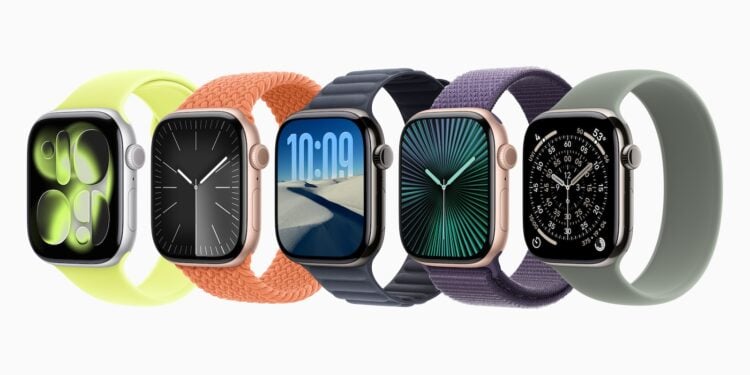The Apple Watch Series 11 was unveiled at this year's Apple event and is causing a stir primarily because of one number: 24 hours of battery life. This would be a significant jump compared to the previous 18 hours. However, a closer look quickly reveals that this increase is not due to technological advances, but rather to a change in the calculation. The Watch itself remains essentially identical to the Series 10.
In recent years, Apple has been rather conservative with its Watch battery life ratings. Despite larger displays, more powerful chips, and new sensors, the typical runtime remained constant at around 18 hours—a realistic value based on everyday use. With the Series 11, this seems to have changed. 24 hours of runtime seems like a huge improvement on paper. The question is: How was this value determined? And what has really changed?
Changed calculation ensures better numbers
The jump from 18 to 24 hours of battery life isn't due to new technology, but rather a different testing approach. Apple has adapted its own measurement method and now also takes into account phases with sleep tracking. This is a scenario with significantly lower energy consumption, as there is hardly any interaction with the device during sleep. These quiet hours are now included in the average usage time - which naturally pushes the value up considerably. Previously, the battery life was calculated based on a typical day with active use: notifications, workouts, music streaming, apps, and display usage. This type of use puts significantly more strain on the battery. Now, with the new calculation model, several hours of sleep per day are also part of the equation - a phase in which the watch hardly consumes any power. This results in an apparent increase of six hours, but this is unlikely to be noticeable in everyday life.
Only minimal changes on the hardware side
Despite the change in measurement method, the hardware has also changed – albeit only slightly. The battery capacity of the Apple Watch Series 11 has increased slightly compared to the Series 10. Depending on the case size, it now ranges between 1245 mAh and 1403 mAh. The previous model had a capacity of 1118 to 1266 mAh. In practice, this results in a real-world increase in battery life of around 7 to 10 percent – a small but measurable improvement. However, this increase only shows up in standardized benchmark scenarios and will hardly be noticeable in everyday use. Actual usage time depends heavily on individual behavior anyway – display brightness, app usage, GPS tracking, cellular connection, and many other factors have a significantly greater impact on battery life than a slightly larger battery.
Criticism of Apple's communication strategy
What many are criticizing is not so much the actual performance of the Apple Watch Series 11, but the way it is communicated. In the past, Apple's battery life figures were considered solid and realistic. The sudden change in the calculation method without indicating that earlier models would have to be re-evaluated according to the same criteria seems dishonest. The integration of sleep tracking into the calculation is understandable from a technical perspective – after all, the feature is now part of daily use for many users. The problem, however, is that this makes a direct comparison with previous generations no longer possible. Anyone who compares the new 24-hour battery life with the previous 18 hours gets a distorted picture. The impression is created that a major leap has been made, but this has not actually happened technically.
Apple Watch Series 11 falls short of expectations
The Apple Watch Series 11 offers no fundamental innovations over its predecessor. The changes primarily concern the marketing strategy surrounding battery life. The actual increase is modest at around 7 to 10 percent and is based on a slightly larger battery. The officially reported 24-hour battery life is the result of a new measurement method, not a technical innovation. Those who already own a Series 10 will hardly notice any difference. For everyone else, the Apple Watch Series 11 offers a solid overall package—but not a revolution. Anyone choosing this model should be aware that the impressive battery life figures should be treated with a grain of salt. What looks good on paper is, in reality, more of a clever mathematical trick. (Image: Apple)
- iPhone Air: All repair costs at a glance
- iPhone Air: Market launch in China delayed due to eSIM
- Apple Watch receives FDA approval for high blood pressure warning
- iPhone 17 and iPhone Air: Now available for pre-order from Apple
- Live translation remains blocked in Europe for the time being
- iPhone Air vs. iPhone 17 Pro: Which is the better choice?
- iPhone Air in detail – Tim Cook on style and lightness
- Apple and politics: New allegations surrounding AI guidelines
- Live translation remains blocked in Europe for the time being
- Apple remains market leader in the premium segment despite competition
- Apple allegedly trained AI with pirated software: Authors sue
- MacBook Pro 2026: Apple plans major upgrade with OLED
- Apple remains market leader in the premium segment despite competition
- Apple launches new MagSafe charger with Qi2 25W support
- iPhone 17 and 5G: mmWave remains reserved for US users
- AirPods Pro 3: Surprise discovered in battery life
- iPhone 17: Differences between A19 and A19 Pro
- iPhone Air weight: Comparison of all current Apple models
- iPhone 17: Apple brings significantly longer battery life
- iPhone 17: Apple introduces groundbreaking security feature
- iPhone 17: Dual Capture Video now directly in the Camera app
- macOS 26 brings repair assistant for calibration & parts
- iPhone Air with C1X modem – faster, more efficient, better
- iPhone 17 Pro uses aluminum – all the reasons in detail
- iPhone 17: N1 chip, more RAM and battery life at a glance
- High blood pressure warnings coming to older Apple Watch models





